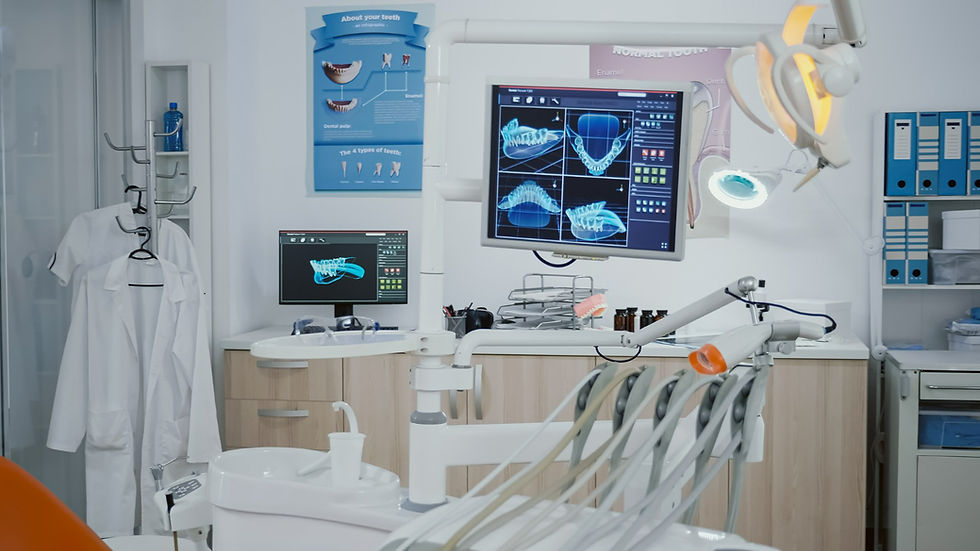The Latest Innovations in Dental Treatment Technology
- zanamedicalcenter
- Jul 10, 2024
- 3 min read

Advancements in dental technology have revolutionized the way dental care is provided, making treatments more effective, efficient, and comfortable for patients. Here’s an overview of the latest innovations in dental treatment technology:
Digital Impressions and 3D Printing
Traditional dental impressions can be uncomfortable and time-consuming. Digital impressions have transformed this process by using advanced scanning technology to create precise digital models of your teeth. Benefits include:
Accuracy: Digital impressions provide highly accurate models, reducing the risk of errors in dental restorations.
Comfort: The scanning process is quick and non-invasive, improving the patient experience.
Speed: Digital models can be used with 3D printers to create dental restorations faster than traditional methods.
Laser Dentistry
Laser technology is being increasingly utilized in various dental procedures, offering several advantages:
Minimally Invasive: Lasers can perform many procedures with less pain and discomfort compared to traditional methods.
Precision: Lasers allow for precise targeting of affected areas, minimizing damage to surrounding tissues.
Faster Healing: Reduced bleeding and swelling lead to quicker recovery times for patients.
CAD/CAM Technology
Computer-Aided Design and Computer-Aided Manufacturing (CAD/CAM) technology has revolutionized the creation of dental restorations such as crowns, bridges, and veneers. Key benefits include:
Efficiency: Restorations can often be designed and fabricated in a single visit, saving time for both patients and dentists.
Customization: CAD/CAM technology allows for highly customized restorations that fit perfectly and match the patient’s natural teeth.
Durability: Materials used in CAD/CAM restorations are strong and long-lasting, ensuring reliable results.
Cone Beam Computed Tomography (CBCT)
CBCT technology provides detailed 3D images of the teeth, jaw, and surrounding structures, enhancing diagnostic capabilities. Benefits of CBCT include:
Detailed Imaging: High-resolution images help in accurately diagnosing complex dental issues.
Improved Treatment Planning: Precise imaging aids in planning procedures such as dental implants and root canal treatments.
Reduced Radiation Exposure: CBCT scans use lower radiation levels compared to traditional CT scans.
Intraoral Cameras
Intraoral cameras are small, handheld devices that allow dentists to capture detailed images of the inside of a patient’s mouth. These images can be displayed on a screen for real-time viewing. Advantages include:
Enhanced Diagnosis: Clear, magnified images help in identifying issues that might be missed during a regular examination.
Patient Education: Patients can see what the dentist sees, making it easier to understand their oral health and treatment needs.
Documentation: High-quality images provide accurate records for future reference.
Teeth Whitening Innovations
Teeth whitening technology has advanced significantly, offering faster and more effective results. Innovations include:
LED Whitening Systems: LED light-activated whitening treatments can provide noticeable results in a single visit.
Customized Whitening Trays: Custom-made trays ensure even application of whitening agents, improving effectiveness and comfort.
Sensitive Teeth Solutions: New formulations minimize sensitivity while still delivering excellent whitening results.
Robotic-Assisted Surgery
Robotic-assisted technology is beginning to make its mark in dental surgery, providing enhanced precision and control. Benefits include:
Accuracy: Robots can assist in performing delicate procedures with high precision.
Consistency: Robotic systems ensure consistent quality and outcomes.
Minimized Invasiveness: Enhanced control can lead to less invasive procedures and faster recovery times.
Conclusion
The latest innovations in dental treatment technology are transforming the field of dentistry, offering numerous benefits for both patients and practitioners. From digital impressions and 3D printing to laser dentistry and robotic-assisted surgery, these advancements are making dental care more accurate, efficient, and comfortable. Staying informed about these technologies can help patients make better decisions about their oral health and treatment options. If you’re considering dental treatment, consult with your dentist to explore how these cutting-edge technologies can enhance your care.

Comments